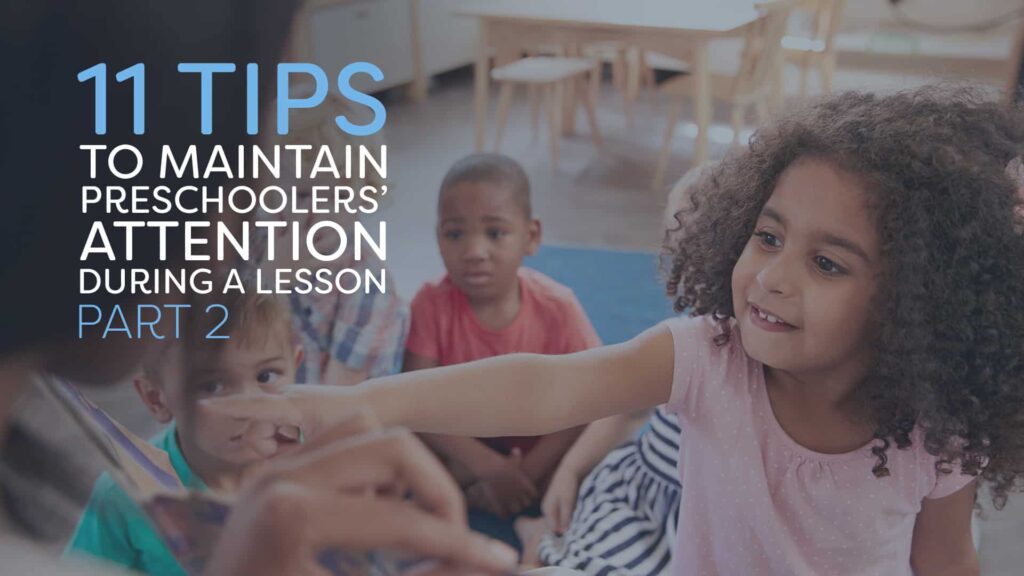Part 2: 11 Tips to Maintain Preschoolers’ Attention and Create Learning Opportunities as You Teach a Bible Lesson

(Part two of a three-part series… Read the previous post for more tips!)
There are 20 wiggly little people on a rug, and it’s your turn to share with them a lesson from the Bible … are you ready?
Despite the wiggles you may observe, preschoolers love a story! For some, listening to a lesson will be their most memorable part of their time with you. When you stand up in front of them, you have the chance to engage them in a special way!
However, for the adult volunteer teaching the lesson, it can be an intimidating experience. Some may feel like they don’t have enough training to pull it off the way they wish they could, and from an outside perspective, preschoolers can seem to be a tough crowd to keep engaged during a lesson.
How can we get a game plan together for keeping their attention? Join us in our series of the 11 tips to coach you through to the victory of a successful Bible lesson!
Previously we covered how to be prepared, use structure to your advantage, bringing your love and excitement with you, and to trust God with your opportunity.
This week we will cover four more tips…
5. Expect the unexpected
By their very nature, preschoolers are an unpredictable bunch, so expect some odd (sometimes positive and sometimes negative) stuff to happen. When it does, you’ll be less frustrated and more accepting of the moment, which will allow you to see it as an opportunity to teach through. Also, expect that God will be at work through those moments. When something unexpected happens, like a child raising a hand during the Bible story to share about a sick relative, stay in the moment with them, and say something that both empathizes (“Oh that must be sad for them and for your family,”) and something that redirects (“Let’s pray for them at the end of our lesson. In our story today there were some people who were sad too.”) Afterwards, you or another leader can find a time to ask that child more about what they share in case there is a need. The unexpected things that come up while working with preschoolers is part of what makes the experience so wonderful. Some are deeply profund, like when a child I was with had a deep sense of repentance from sin, and prayed, “Jesus, you are my behave,” meaning she knew it was only in God’s power that she would be able to follow His commands– so deep! I remember one time a boy in my Sunday class proudly declared, “when I grow up I want to be a sea turtle.” What are some of your favorite unexpected moments? Enjoy them!
6. Be proactive and monitor your group
At this age, many preschoolers may not even be aware of themselves enough to know that they have tuned out, or are poking their neighbor or picking at the carpet. That’s okay—it is your job to monitor the group, and when you see that they are tuning out, you can decide that you are going to bring their focus back to the lesson. Preschoolers have limited attention spans. The old adage goes that a child’s attention span is about as many minutes as they are years old—so a 4-year-old would have a 4-minute attention span. While this is debatable (the latest research actually says 10 minutes is what we can expect) the reality is it isn’t possible to expect preschoolers to sit very long without some ways to reset their focus and attention. As soon as you realize you need their attention back, use a redirect to keep things from spiraling, and consider using them even before you need them!
7. Have a few redirects ready
You can push the reset button by engaging their senses! If your lesson time goes for 15 minutes, expect that you will need to refocus their attention at least 3 times, and be prepared with a few ways to do this. Does this take a few minutes of your lesson time? Yes, but you will then have them listening to what you’re teaching them!
Some ideas include:
- Using motions as you teach (For example: “In this story we will be talking about a house. Can everyone make a house shape by putting your hands over your head? There were people there. Can you point to everyone around you and say people?”)
- Asking the class to stop and copy your movements until you feel that you’ve regained their attention (For example: “Can everybody touch their nose? Now can you touch your ear?”)
- A call and response (For example: Teacher says “Kids, Kids” and the class says “Yes, Yes.”)
- Inviting kids to come up and touch an object you are using in your lesson (For example: “When Jesus blessed the children, He was happy to be with them. Look at this teaching card picture and come touch his happy face, then sit back down.”)
If you want to be super awesome you can create a sheet that has some of these for easy reference to use when you anticipate or realize your group needs to refocus.
Final thoughts…
When Jesus said “Let the little children come to me” in Matthew 19:14, He didn’t expect them to stop acting like children, but He did expect them to walk away from an encounter with Him impacted by the time they spent with Him.
As we teach preschoolers we are also inviting them to an encounter with God through His word, and hopefully, these tips will help you do just that!
Interested to know the other tips? Read the other parts of this series!
